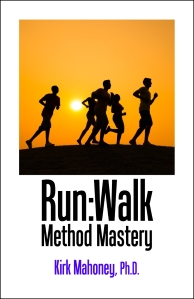Can Lowering Your Run:Walk Ratio Make You Faster?
 Can lowering your run:walk ratio make you faster?
Can lowering your run:walk ratio make you faster?
I have wondered about my own run:walk ratio for several years.
It started when I ran my fastest marathon — still to this date — with the 2:1 method instead of my usual 5:1 method.
It continued as I kept noticing that 3:1 athletes in races seemed to be faster than me using the 5:1 method.
I suspect that at least some of those 3:1 athletes would be faster than me even if I were using the 3:1 method.
Still, seeing 3:1 athletes pass me in races has made me wonder whether I have been using the wrong run:walk ratio.
So, can lowering your run:walk ratio make you faster?
My Latest Experience
My marathon-training group holds its long runs on Saturday mornings. Look at these two runs, each of which started at 5 AM but in the same high heat + humidity. (Welcome to Houston!)
- Aug. 22, 2015:
- 3:34
- 15.00 miles with 5:1 method
- 14:16/mile average pace
- Sep. 5, 2015:
- 3:37
- 16.18 miles with 3:1 method
- 13:24/mile average pace
Yes, the first run may have given me a training effect that helped me in the second run. But:
- The second run was more than a mile longer than the first run.
- The second run was with the 3:1 method instead of the 5:1 method.
So, I covered more ground, and I walked more often. But, my average pace was 52 seconds/mile faster with the 3:1 method than with the 5:1 method!
And, I have never seen in my many years of marathon training this large of an improvement due to training effect alone.
Conclusion and Recommendation
Conclusion:
[Tweet “Lowering your run:walk ratio CAN give you a faster average pace.”]
I cannot tell you what your pace-optimizing run:walk ratio is. You have to discover this for yourself.
Recommendation:
- Be willing to experiment with your run:walk ratio from run to run.
- Cover the same or similar distances for several runs.
- Wear a pedometer, and note your steps, as well as your average pace, as soon as you finish each run.
I doubt that I have found my optimal run:walk ratio. All I know at this point is that I had a 3:1 run that gave me a faster average pace than did a 5:1 run of about the same distance. I plan to follow my own recommendation so that I can find my optimal ratio.
An Astounding Twist
Look at the same two runs, but with an extra fact for each.
- Aug. 22, 2015:
- 3:34
- 15.00 miles with 5:1 method
- 14:16/mile average pace
- 27,351 “aerobic” steps
- Sep. 5, 2015:
- 3:37
- 16.18 miles with 3:1 method
- 13:24/mile average pace
- 26,597 “aerobic” steps
The “aerobic” step-counts came from my Omron pedometer. Here’s Omron’s definition of “aerobic” steps, which are always fewer than the totality of steps that the pedometer counts:
Aerobic steps are counted separately when walking [or running] more than 60 steps per minute and more than 10 minutes continuously. If a rest of less than 1 minute is taken after a continuous walk [or run] for more than 10 minutes, this will be regarded as part of a “continuous walk [or run].”
This means that it is a good idea to compare aerobic step-counts across two runs. They exclude “walking around” steps such as during warm-up exercises with my training group.
Let’s compare the 3:1 run to the 5:1 run in two ways:
- I went 7.87% farther — 16.18 miles instead of 15 miles.
- I took 2.76% fewer steps — 26,597 steps instead of 27,351 steps.
Suppose I had covered 16.18 miles — instead of 15 miles — with the 5:1 method. Then:
- Simple extrapolation predicts that I would have taken 29,503 steps with the 5:1 method.
- 16.18 miles with the 3:1 method required 9.85% fewer steps than would the 5:1-method run extrapolated to 16.18 miles.
Look, I wrote Run:Walk Method Mastery, but even I find this astounding.
Yes,…
- You likely will take fewer steps when covering the same distance at a faster pace.
- I had a faster average pace in the second run than in the first run.
But,…
- More frequent walking accompanied my faster average pace!
Astounding, right?
I walked more often, which requires more (aerobic) steps per given distance than does running. But, I took fewer (aerobic) steps in total with the 3:1 method than with the 5:1 method.
What does this suggest?
A Corollary to the Conclusion
Corollary
- Lowering your run:walk ratio may improve the average pace of your running phase so much that it more than compensates for the higher frequency of your walking phase.
In plainer English:
[Tweet “A shorter running phase can improve running pace so much that it overrides more frequent walking.”]
I don’t know about you, but I find this exciting!
Where Do We Go from Here?
So, how do you find the run:walk ratio for you that gives you your fastest average pace?
My recommendation (above) still stands: Experiment. Track. Analyze.
There’s something extra, though, that you can do, once you have found your optimal run:walk ratio.
That something extra even applies for run-only and walk-only endurance athletes.
To learn more about this, be sure to join the SpryFeet.com Readers Club. Membership is free, and I’ll be soliciting members by email to help me with research into this something extra.
I hope that you will join me in research into what I believe will make you a happier runner, walker, or run:walk athlete!